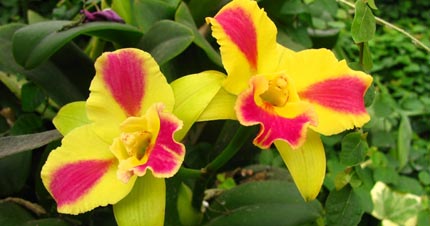You may have heard about Haifa's spectacular Baha'i Gardens or Jerusalem's Botanical Gardens. But what about Ramat HaNadiv on Mount Carmel? Or the Utopia Orchid Park at Kibbutz Bahan? Israel's public gardens span the country. Let's start at the top.
Northern Israel
More than half a million visitors every year take advantage of free guided tours of colorful groomed geometry in the two Bahá'í Gardens. Located about 10 miles apart in Haifa and Acre (Acco), the gardens are designated UNESCO World Heritage sites as holy places and pilgrimage destinations for followers of the Bahá'í faith.
The Haifa gardens comprise 19 landscaped terraces extending up the northern slope of Mount Carmel overlooking Haifa Bay with approximately 1,700 steps. More than 450 plant species, mostly native to the region, were chosen for their color, height, hardiness and ability to survive with a minimum of water. The smaller Bahá'í Gardens in Acre, north of Haifa, form a wide circle framed with cypress trees and plantings.
"It's a bit hidden from the main road, and recently we purchased land between the gardens and the main road to expand the gardens so they will be a lot more visible to passersby," says Jalal Hatami, deputy secretary general of the Bahá'í International Community.
Both gardens are tended by volunteers from about a dozen countries, and do not charge admission fees. "The way we see it, we're trustees of these sacred, special places for all of humanity," says Hatami. "We don't see them just as our own, but for everybody."
At the southern end of Mount Carmel south of Haifa, between Zichron Ya'akov and Binyamina, Ramat Hanadiv Memorial Gardens and Nature Park was set up as a memorial to Baron Edmond de Rothschild, a major benefactor to pioneers working to found the State of Israel.
Wheelchair-accessible pathways throughout the fragrant Memorial Gardens meander among a combination of formal European and Mediterranean-style plantings, pine and cypress groves surrounding the crypt of the baron and his wife, Adelheid. The groves were the gift of Keren Kayemeth LeIsrael-Jewish National Fund.
In the Nature Park, you can walk along circular hiking trails with plenty of observation points. The park has an acclimatization cage where rehabilitated birds of prey are prepared for release back into the wild. Ramat Hanadiv's Visitors Pavilion, Israel's first certified "green" sustainable building, has an auditorium that shows a film about the site; a nature exhibition gallery; and Scenicafé, a kosher dairy café-restaurant serving fresh seasonal specialties with aromatic herbs and olive oil, fine wines and goat's milk beverages. There's a playground adjacent to the restaurant and the park offers a variety of family activities, such as bird-ringing, concerts and lectures all year long.
Central-Tel Aviv region
Located between Netanya and Hadera, Utopia Orchid Park at Kibbutz Bahan displays more than 20,000 orchids, some of them rare species, growing on rocks, trees and on the ground. This is one of the only parks of its kind in the entire Middle East.

One of the many rare specimens at Utopia Orchid Park
The 10-acre site has much more than orchids, though: There's a butterfly house, two walk-through plant mazes, a petting zoo, a musical fountain and shady lawns. The green grounds, populated by goats, spotted deer, sheep, peacocks and rabbits, are dotted with natural wonders such as waterfalls, pools, fish, birds and tens of thousands of tropical plants.
Utopia Orchid Park also has a vast collection of carnivorous plants that thrive and reproduce in a swamp created just for them. Visitors can see how the carnivorous plants grow and are cultivated, and how they capture prey.
Tel Aviv University's Botanical Gardens are a center of natural beauty, learning and research overseen by the Department of Plant Sciences of the George S. Wise Faculty of Life Sciences. The Noah Naftulsky Ecological Garden features the dominant species found in Israel's five phytogeographic regions - the Mediterranean, Saharo-Arabian (desert); Irano-Turanian (steppe); Sudanian (tropical); and Euro-Siberian. Specialized gardens include one planted with medicinal plants, another with endangered species and an additional one for the enjoyment of sight-impaired visitors.
One of the main attractions is the Daphna Carasso Garden of Tropical Plants, which combines natural features from the Amazon Rainforest and the jungles of Africa and Southeast Asia. Thousands of species make this Israel's largest collection of tropical plants: giant bird of paradise plants, delicate Australian tree ferns, rare orchids, sharp-toothed carnivorous species, coffee, vanilla and cacao flourish in a carefully controlled environment. Concentrated around a large central greenhouse, the Carasso Garden includes smaller satellite greenhouses and outdoor beds planted with ornamentals, ferns, bromeliads and orchids.
Situated minutes from Ben-Gurion International Airport, Neot Kedumim - the world's only biblical landscape reserve - covers more than 620 acres. Its picturesque landscape features plants and trees, water and agricultural installations - olive and wine presses, threshing floors, cisterns, and ritual baths - as they would have appeared some 2,000 years ago. The non-profit Neot Kedumim has received international recognition as a model of restoration ecology, and in 1994, won the Israel Prize for its special contribution to the society and the state.
Neot Kedumim was established in 1970 to be a network of natural and agricultural landscapes sourced from the Bible. Thousands of tons of soil were trucked in and spread on the eroded hillsides, reservoirs were dug to catch runoff rainwater and ancient terraces were restored. Habitats were created for cedars from the snow-covered mountains of Lebanon and date palms from Sinai desert oases, and everything in between. The garden's routes include the Forest of Milk and Honey, Dale of the Song of Songs, Isaiah's Vineyard and the Fields of the Seven Species.